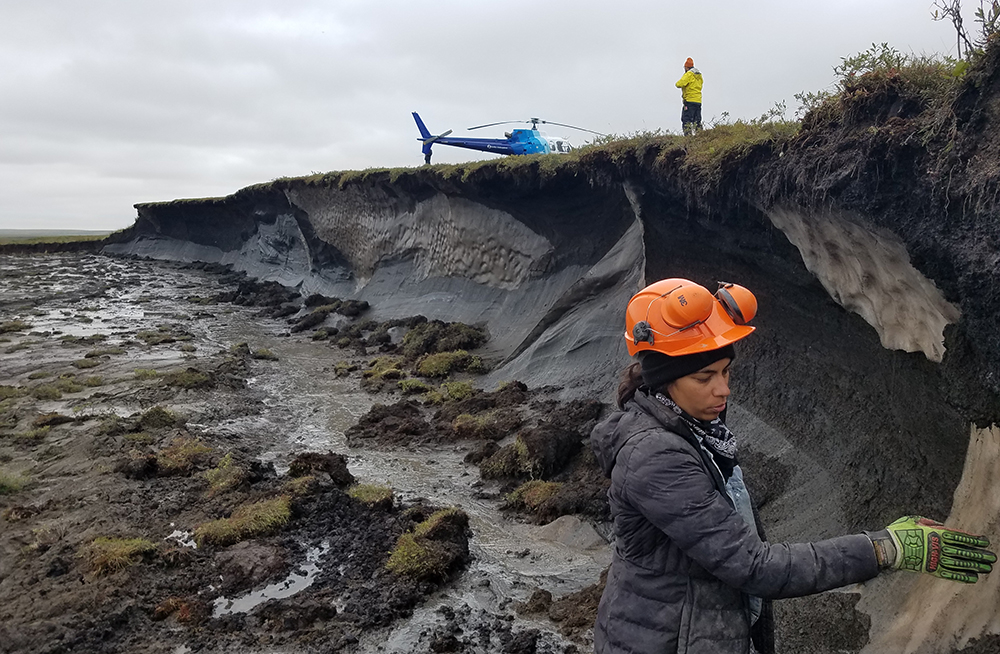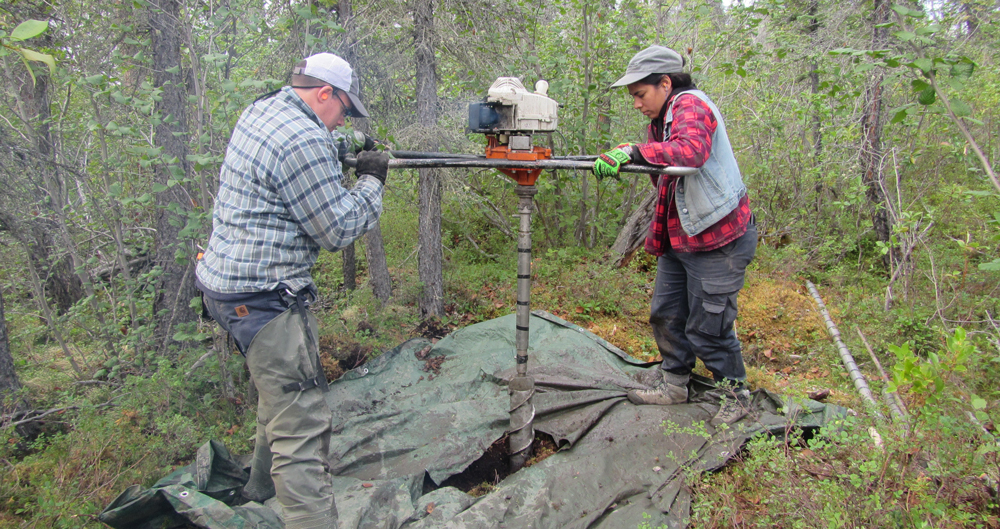NURTURING A RESILIENT EARTH
Unearthing the “carbon bomb” hiding underground
By: Liz Do & Alison Rutka
24 Oct, 2023
The effects of climate change can be felt globally at an alarming rate. CIFAR is at the forefront of addressing it. This special series, Nurturing a Resilient Earth, takes a closer look at how CIFAR’s community — across borders, roles and disciplines — is making a meaningful impact to bring about powerful change.
Learn about how CIFAR researcher Jacqueline Goordial’s studies into carbon-emitting microbes have the power to slow rapidly-thawing permafrost.
Want to learn more about their research?
Watch: CIFAR Talks: Nurturing a Resilient Earth featuring researchers from the series.

Photo by Josh Fee
Jacqueline Goordial, a CIFAR Azrieli Global Scholar in the Earth 4D: Subsurface Science & Exploration program, recalls her last visit to the Canadian Arctic. From the helicopter, she and her team flew over a large permafrost site that is thawing at such a pace that the edges of its structure are slumping, as though a giant had taken a bite out of the soil underneath the surface.
Once on land, and venturing through thigh-high mud and tundra, the team drove their instruments deep into the permafrost face, next to a thousand year old wedge of ice formation — they were there to measure methane levels seeping out from the frozen ground.
The next day, they came back to find the permafrost thaw face had melted away, along with their instruments.
“That was less than 24 hours,” says Goordial. “This is a structure that’s been frozen for thousands of years, and I see it erode in real time, inch by inch, within a day.”
The rapid erosion of permafrost is one of a myriad of alarming examples of the effects of climate change — whether it is shrinking glaciers, frequent extreme weather events, increased food scarcity or rising sea levels. Goordial’s work examines how microbial life persists within extreme subsurface environments such as permafrost and oceanic crust/marine sediments.
Though Goordial’s instruments were irretrievable in that instance, her team has been successful in collecting methane data in the Canadian Arctic.
“We install chambers into the face of the permafrost and one of the things that we see is that there is an instant release of methane coming from these fast erosional features,” explains Goordial. “We have a lot of old carbon frozen away.”
As the permafrost is rapidly melting, it is releasing trapped methane from microorganisms underground. Methane is 25 times as potent at trapping heat in the atmosphere as carbon dioxide (CO2), and eventually combines with oxygen to create CO2.
Permafrost in the Northern Hemisphere is currently trapping about 1,700 tonnes of carbon, including methane and CO2. In a March 2021 feature in Nature on effects of thawing permafrost, climate scientists describe the disappearing permafrost landscape as having the potential to trigger a massive “carbon bomb.”
“One of the things that we fear will happen when it thaws is some of that carbon will become newly available to microorganisms that have gone from this frozen state, to a warmer state. Then, through their own metabolism, these microorganisms will convert that carbon into more greenhouse gases,” explains Goordial.
How does CIFAR help you do impactful work to address climate change?
"Through CIFAR I have been given opportunities to learn about how to interact with policy makers, how to curb disinformation, and how to engage with media through mediums like op eds; These are tools I would not have obtained otherwise, but that will help me ensure that the work I and others are doing in this sphere have real world impacts beyond academic papers."
Top Left and Right: Jacqueline Goordial taking measurements of a thaw slump in the Northwest Territories. Thaw Slumps occur when permafrost rapidly degrades, creating a landslide like feature as the soil thaws and turns to mud. The "wall" in the photos are frozen permafrost, and ice wedge features are visible.
Right: Jacqueline Goordial and a graduate student drilling through the thawed portion of the soil, into the permafrost. They use this technique to recover ~3 metres of core material.
All photos courtesy of the researcher
Although microbes have the deadly potential to create more greenhouse gases, for Goordial, they may actually be part of the solution to climate change.
“Microbes can actually eat and sequester methane,” she notes. “They potentially have a role to play in mitigating the extent of methane that does get released. Our lab is trying to figure out the balance between the methane-eating microbes and the methane-producing microbes, and the conditions that may favour one type over another.”
Understanding the right conditions to tap into the carbon-sequestration powers of microorganisms is crucial for Goordial and her team, as it deepens their knowledge of what it takes to generate ‘net methane sinks’ (areas in which microbes are actually sequestering methane) across various geological settings. Without this fundamental knowledge, it will be difficult to make carbon budgets that account for true natural emissions, limiting our ability to make relevant carbon emission targets as a society.
Though the realities of climate change in the Canadian Arctic sometimes feels daunting for Goordial, she remains hopeful that her contributions, and that of others within CIFAR, will bring upon positive change.
“Climate change is one of the most pressing issues of our time. It's bigger than us,” says Goordial. “And I feel like I have this opportunity — the skill set and intellectual knowledge — to contribute in my small way to understanding the problem. I’m contributing to the frontiers of science for humanity, our search outward.”


